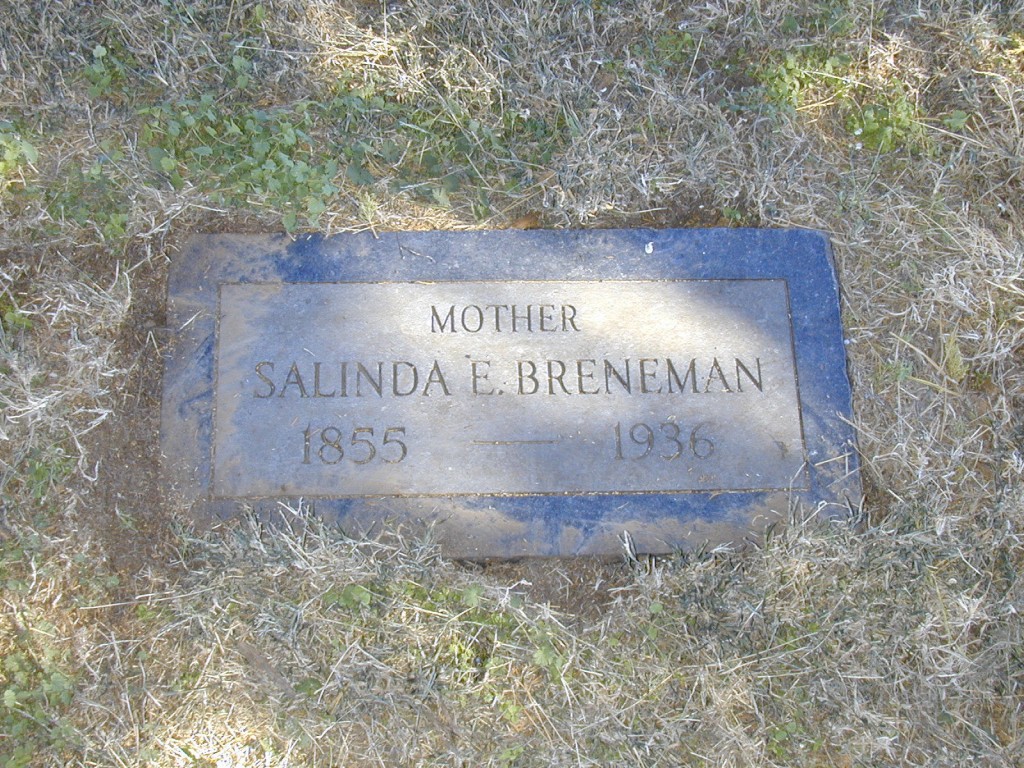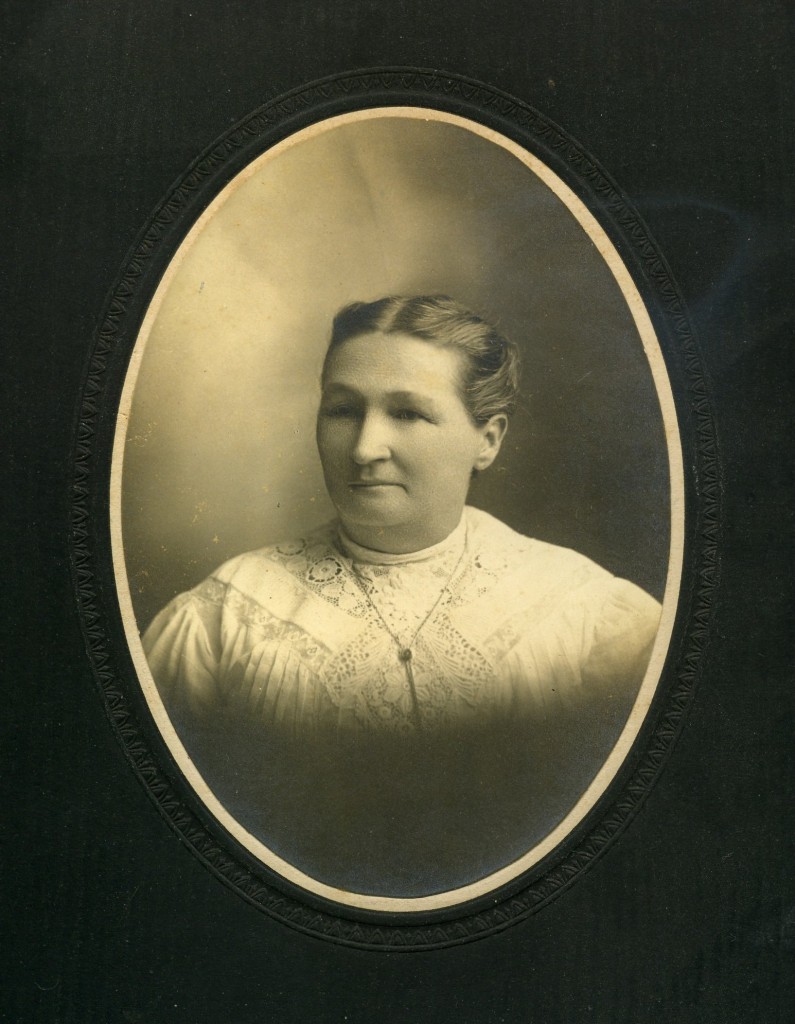Posts Tagged ‘photo preservation’
Tombstone Tuesday – Salinda E. (Rose) Breneman
Sherry Stocking Kline
December 8th, 2009
Salinda (Rose) Breneman, daughter of Eden and Elsie/Elcy Rose, is my great-grandmother on my mother’s side.
Looking at this photo today, I wish I’d been better prepared to take tombstone photos. I should have had a soft whisk brush with me, a cloth, something to carry water to the stones, and perhaps even a tiny rake, or grass shears in some places.
Shown on the Stone:
Mother
Salinda E. Breneman
1855 – 1936
Great-grandmother Salinda is buried in the Milan Cemetery, Ryan Township, Sumner County, Kansas. The cemetery is about 12 miles west of Wellington, KS on Highway 160.
She is shown with her parents and siblings on the 1860 census when she is just 7 years old.
1860 Census 4 July 1860
Grand View Township, Louisa County, IowaFamily 344 – 342
Edan Rose – 34 – M – Farm Labour
Elcy Rose – 32 – F
Abram (Abraham?) – 13 – M
Salinda – 7 – F
Absalom – 3 – M
Salinda Rose Breneman is the mother of Ira, Albert, Harvey, and Otto, Carrie and May. You can see photos of her children as well as a photograph of Albert’s tombstone here.
Salinda was married to Constantine “Tom” Breneman, but they divorced later in life.
If you’ve done a family search for the Breneman or Rose families, and landed on this page, I hope you will leave a comment and contact info so we can share our research!
Journal Your Summer Photos Now!
by Sherry Stocking Kline
first published in Wichita Eagle’s Active Life Magazine – September 2000
Now that summer’s over, and you’ve got a shoebox full of vacation, grandchildren, wedding, and graduation photographs, it’s time for you to preserve those memories between the pages of a book, like a pressed flower, to be enjoyed again and again.
So where do you start first?
“Get some history attached to those photos,” said Bob McCreary, “that’s the first and probably the most important step.”
McCreary and his wife Kathy co-own Scrapbook Garden, Wichita, Kansas. McCreary said that Kathy carries photographs with her in her purse and whenever she has a few minutes while watching television, waiting for the doctor, or waiting to get a driver’s license she sorts photos and makes quick notes on the back with a photo safe pencil.
Once you have them sorted, McCreary said it’s really a quick step after that to put the photos in an acid-free, lignin-free photo album, and then “journal” or tell about the photos.
Each year, Gerry Reimer does a summer vacation album, and adds more pages to her all-Christmas album.
Journals Don’t Have to Be Elaborate…
Reimer said not to let your friends’ elaborate journals scare you off. “Streamline,” Reimer said, “get the photos on the page, and get the people identified.”
“First of all,” Reimer said, “Tell yourself it’s o.k. not to use all the photos you have.” Reimer said to choose pictures that tell who you are and where you were at that time, and be sure and include names and dates in your albums.
“I don’t keep a travel diary,” Reimer said, but Reimer said she jots down a few notes, picks up ticket stubs, colored brochures, saves travel itineraries and whatever else they might want to use in their vacation albums.
Reimer said you’ll know what you want to do, and what you don’t, after you finish your first book. Reimer’s first photo album was her wedding album.
“We’d been married 49 years,” Reimer said, and I didn’t like our wedding photos, so I had a wonderful time cropping off what I didn’t like and journaling about the pictures.” Reimer said she does “bullet journaling”, or writes short statements under most photos, saving long stories for special photographs or events.
Start With Recent Photo’s…
Bonnie Loewen, Creative Memories consultant, said the easiest way to get started is with your last roll of film while your memory of the event is fresh, and work your way backwards.
Tell A Story…
Loewen said to tell a story with words as well as with pictures. How were you feeling? What was going on in the family, and the world? Loewen said even the current price of bread and gasoline will be interesting to future generations.
Loewen said to write as you would talk, don’t worry about punctuation, and write a sloppy first draft. You can re-write it later, Loewen said.
Answer the Five W’s – Engage the Five Senses…
Think about the five senses and the five W’s, advised both McCreary and Loewen, adding that it will make ideas for captioning your photos come easier. Just remember to answer the questions who, what, when, where, and why questions, and engage the emotions by writing about how something looked, sounded, tasted, felt, and smelled.
Preserve Your Handwriting, too…
McCreary said and its faster to use a computer to journal, but it’s not as personal, so he said not to be afraid to write in pencil and go over it later with a permanent marker, or even cover up mistakes with cardstock.
“Some people don’t like their handwriting,” McCreary said, “but people years from now will cherish seeing the handwriting of the person who made the journal.”
Scrapbooks can help bridge the generation gap, so along with vacation, wedding and family photos, include stories and pictures of military service and other events to help future generations understand the times you lived through, and what makes your family special.
Ordinary Days are Important…
Loewen said it’s also good to make pages of what an ordinary day was like in your family, too, not just the special events. “And make a signature page,” Loewen said, with your name, date, who the album is for, and why you did it, “it’s kind of like signing a quilt.”
If you have a lifetime of photographs ask for help from your family. Reimer said that kids and grandchildren are great to help photo captions.
McCreary agreed, “it’s good to get family members involved.”
“Make it a fun activity,” McCreary said, “have everyone sit down and talk about the photos, and try to communicate some of the emotion.” You get different perspectives of an event by talking to different people.
“It’s really exciting that people are making a legacy and trying to pass on their roots and their values,” Loewen said, “values can be lost in one generation if they are not preserved.”
“People will forget you in one generation if you don’t tell your story,” Loewen said, “you can make such a difference in people’s lives with a scrapbook.”
“In a sense,” Reimer said, “your whole book is the story of your family.”
Can You Salvage Damaged Photographs?
By Sherry Stocking Kline
published in the Wichita Eagle’s “Active Life” magazine in November 2005
If disaster strikes, whether it’s Hurricane Katrina, your water heater sprung a leak, or your photographs have water and smoke-damage from a fire, don’t make the trash your first destination of choice for the remains.
Sometimes, even wet, stuck together photographs can be salvaged, but you have to act fast.
“A lot depends on the circumstances,” said Darrell Garwood, preservation officer, library archives division, Kansas State Historical Society, “There is a lot of dirt and contaminants in flood water,” Garwood said, “If they have been in water, especially dirty water longer than 48 hours they may not be able to be re-claimed.”
A lot also depends on what type of photographs are damaged. Are they fairly modern? Are they old? One-of-a-kind? Hand-tinted? What kind of paper are they on?
Before you do anything, you need to know what kind of photographs you are dealing with, and it may be necessary to consult a professional for help. To help you determine what kind of photographs you can safely repair yourself, or if you have no choice but to attempt the repair yourself, there are books, such as “How to Save Your Stuff From a Disaster” by Scott Haskins, and websites such as Northeast Document Conservation Center, www.nedcc.org, and the Kansas State Historical Society’s website at www.kshs.org, (click on preserve) can help you determine what kind of photographs you have, and how best to preserve them.
According to Gary Albright, senior paper/photograph conservator, Northeast Document Conservation Center, there are a number of different photographic processes, and while some photographs can be immersed for a day or more and still be restored, others will be completely ruined by a just a few minutes of water exposure.
“Time is of the essence: the longer the period of time between the emergency and salvage, the greater the amount of permanent damage that will occur,” Albright said.
Haskins stated that it’s best to consult a professional who can deal with the photographs without adding to the damage, especially if you have old or vintage photographs.
Wet photographs should always be a priority. Albright said that wet photographs should be air dried or frozen as quickly as possible to prevent mold damage. (Yes, he really did say frozen.)
If the photographs are still wet, it’s best to put them in clean, cool water, distilled water. Change the water often to make sure the water stays clean. Do not use bleach, detergent, fungicide or disinfectants. Do not touch, rub, scrub, or try to force stuck-together photographs apart. Handle them by the edge only, preferably with a blunt, clean pair of tweezers.
Drain excess water off the photographs, and lay them out flat, and separated, on clean, lint-free material to dry. Do not use newspapers. Negatives should be hung up by the edges to dry vertically. Circulate the air the help speed up the drying process and to prevent mold. Do not use a heater.
Can’t deal with them right away? Freeze any photographs that cannot be cleaned and dried within 72 hours.
If they are already wet, rinse off any dirt, mud, etc., separate photos or groups of stuck together photographs with wax paper, put them into zip lock freezer bags and put them in the freezer. Do NOT stack anything on top of them.
If your photos are damaged, you still may be able to scan them at 300dpi or better, and use image editing software such as Adobe Photoshop or Corel’s Paint Shop Pro to repair copies of your damaged photographs. You can use that new, digital copy to make new photographs.
Garwood stated that prevention is the most important thing, and Garwood agreed.
“Address prevention first,” Garwood said, “store them properly and avoid basement storage because basements are always the first thing to flood in a house.”
After prevention, Garwood suggested that you spend a little time in disaster preparedness. Know where your photographs, family letters, video tapes, DVD’s, and important papers are, so you can go right to them for a speedy recovery should it become necessary.
If possible, Garwood said, have back-ups and replacements.
“Make this part of your emergency preparedness plan, and remember that your papers and photos are not as important as yourself,” Garwood said, “People should always come first in a disaster.”
2009 Author’s Suggestion: Before freezing or beginning any restoration attempts, consult with professionals if at all possible.
This article idea came to mind following Hurricane Katrina, and the tornado that struck the Haysville, Kansas area. We drove through the tornado devastation where houses were turned into matchsticks, and papers and pictures were blowing in the wind. I realized that after life and limb were safe, it was the thought of losing my photographs that bothered me most if we were to be struck by a tornado.






